Germany
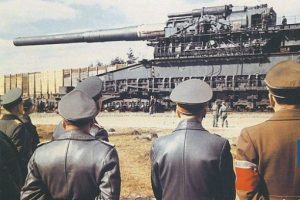 In 1934, Hitler had one problem…the French Maginot Line was the one thing standing in the way of Hitler invading France. In reality, it was the only thing that stood between Hitler and all of Western Europe. The French Maginot Line was a fortification running from the Rhine River to La Ferté consisting of concrete blockhouses, bunkers, and rail lines. The line was elaborate and extensive, and as rumors of its strength made their way to Germany, Hitler began to believe he’d need a miracle for his troops to break through it. Hitler believed that he needed the biggest gun in history.
In 1934, Hitler had one problem…the French Maginot Line was the one thing standing in the way of Hitler invading France. In reality, it was the only thing that stood between Hitler and all of Western Europe. The French Maginot Line was a fortification running from the Rhine River to La Ferté consisting of concrete blockhouses, bunkers, and rail lines. The line was elaborate and extensive, and as rumors of its strength made their way to Germany, Hitler began to believe he’d need a miracle for his troops to break through it. Hitler believed that he needed the biggest gun in history.
Engineers from Krupp, a steel company from Essen, were commissioned by the German High Command (OKH) to design a weapon powerful enough to break through the concrete fortifications that were nearing completion. The shells alone had to be strong enough to penetrate 22 feet of reinforced concrete and at least three feet of steel plating, meaning the weapon had to be massive. It had to be to hold and shoot shells large enough to bring such massive destruction. In order to meet the requirements that Hitler had set forth, Krupp engineer Erich Müller calculated that the weapon would have to be far bigger, and much more powerful than any weapon in existence. After much calculation, Müller put together the measurements for his goliath gun and presented the plan to the OKH.
Though Hitler made no formal commitment, the high command knew the design, known as the Schwerer Gustav, was their answer. With a caliber of 31 inches, able to fire a projectile that weighed more than 10 tons 30 miles away, the Schwerer Gustave was incredibly imposing. The barrel was over 100 feet long, longer than any gun barrel in existence, and the body of the gun was bigger than any tank to see battle so far. It was more like a small building than a gun. From the ground up it was almost four stories tall. It was over 150 feet long including the barrel, and weighed over 1,300 tons. To compare it to things of today, the Space Shuttle weighs 2,000 tons. This was no tiny tank. The shells alone, which had been designed with pure destruction in mind, were taller than two men, twice as wide as one, and weighed 20,000 pounds each. It took several men just to load one into the barrel. For the gun to move around, the body was built on two parallel sets of rail wheels, allowing it to travel across special tracks.
Ultimately, two of these weapons were ordered by the high command, the Schwerer Gustav and a smaller model they called “Dora.” However, the models weren’t ready by the time Hitler was, and the Germans were forced to invade France without them. Of course, they shouldn’t have been worried, as their troops far 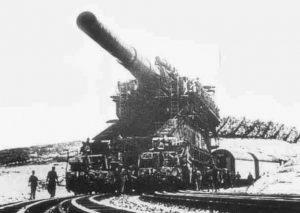 outnumbered the French’s static defenses. Even after the French quickly surrendered, Hitler still wanted to make use of his magnificent and destructive weapon. The siege of Sevastopol was the perfect opportunity. After five weeks of positioning the device, requiring 4,000 men, the weapon was ready. In five days, spanning between June 5 and June 17, the Schwerer Gustav fired 48 rounds, equaling 30,000 tons of ammunition. The barrel of the gun, which had already fired 250 rounds during testing, was worn out entirely. It took 500 men just to fire the gun, and after loading the oversized shells into the machine, they were exhausted. While the gun was daunting to anyone who saw it in action, it really wasn’t very practical.
outnumbered the French’s static defenses. Even after the French quickly surrendered, Hitler still wanted to make use of his magnificent and destructive weapon. The siege of Sevastopol was the perfect opportunity. After five weeks of positioning the device, requiring 4,000 men, the weapon was ready. In five days, spanning between June 5 and June 17, the Schwerer Gustav fired 48 rounds, equaling 30,000 tons of ammunition. The barrel of the gun, which had already fired 250 rounds during testing, was worn out entirely. It took 500 men just to fire the gun, and after loading the oversized shells into the machine, they were exhausted. While the gun was daunting to anyone who saw it in action, it really wasn’t very practical.
 One of the weapons of naval warfare that all of us know about is the torpedo. Beginning in the 1870’s, torpedoes were rapidly introduced into the navies of many states and soon became the primary weapon of destroyers, submarines, and torpedo boats, cruisers, and ships of the line of that period were also armed with torpedoes. Torpedoes were first used by Russian vessels in the Russo-Turkish War of 1877–78. So torpedoes weren’t new on March 26, 1941, when Italy attacked the British fleet at Souda Bay, Crete, using these new detachable warheads. These torpedoes were different however, and I can only imagine how the men on the deck of the British cruiser must have felt as they watched the streaking torpedo coming toward them.
One of the weapons of naval warfare that all of us know about is the torpedo. Beginning in the 1870’s, torpedoes were rapidly introduced into the navies of many states and soon became the primary weapon of destroyers, submarines, and torpedo boats, cruisers, and ships of the line of that period were also armed with torpedoes. Torpedoes were first used by Russian vessels in the Russo-Turkish War of 1877–78. So torpedoes weren’t new on March 26, 1941, when Italy attacked the British fleet at Souda Bay, Crete, using these new detachable warheads. These torpedoes were different however, and I can only imagine how the men on the deck of the British cruiser must have felt as they watched the streaking torpedo coming toward them.
The difference between the torpedoes of old, and these new torpedoes, was that these were manned torpedoes. No, there weren’t men on the torpedo known as the Chariot.” Nevertheless it was unique. Primarily used to attack enemy ships still in harbor, the Chariots needed “pilots” to “drive” them to their targets…basically a guided missile system…but in a very primitive form. Sitting astride the torpedo on a vehicle that  would transport them both, the pilot would guide the missile as close to the target as possible, then ride the vehicle back, usually to a submarine. The Chariot was an enormous advantage, because before its development, the closest weapon to the Chariot was the Japanese Kaiten–a human torpedo, or suicide bomb, which had obvious drawbacks. I can’t imagine being ordered to pilot that one, but then the Japanese were known for their suicide attacks.
would transport them both, the pilot would guide the missile as close to the target as possible, then ride the vehicle back, usually to a submarine. The Chariot was an enormous advantage, because before its development, the closest weapon to the Chariot was the Japanese Kaiten–a human torpedo, or suicide bomb, which had obvious drawbacks. I can’t imagine being ordered to pilot that one, but then the Japanese were known for their suicide attacks.
The Italian attack was just the first successful use of the Chariot, or any other manned torpedo, although they referred to their version as Maiali, or “Pigs.” On that March day, six Italian motorboats, commanded by Italian naval commander Lieutenant Luigi Faggioni, entered Souda Bay in Crete and planted their Maiali along a British convoy in harbor there. The British cruiser, York was so badly damaged that it had to be beached. The manned torpedo system proved to be the most effective weapon in the Italian naval arsenal, and it was used successfully against the British again in December 1941 at Alexandria, Egypt. Italian torpedoes sank the British battleships Queen Elizabeth and Valiant, as well as one tanker. They were also used against merchant ships at 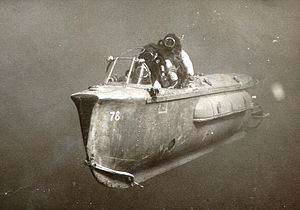 Gibraltar and elsewhere.
Gibraltar and elsewhere.
Deeply angered, the British avenged themselves against the Italians, by sinking the new Italian cruiser Ulpio Traiano in the port of Palermo, Sicily, in early January 1943. An 8,500-ton ocean liner was also damaged in the same attack. After the Italian surrender, the use of the manned torpedo continued to be used by both the British, and later the Germans. In fact, Germany succeeded in sinking two British minesweepers off Normandy Beach in July 1944, using their “Neger” torpedoes. These would be the best torpedo, until the guidance systems could be invented.
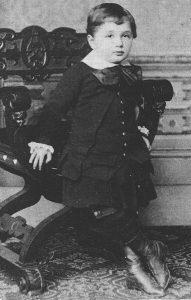
 When I think of a genius, my favorite genius always comes to mind…Albert Einstein. He doesn’t have the highest recorded IQ in history, and in fact, is listed as 12th among geniuses. Nevertheless, Genius Day…a day to highlight the greatest minds out there, falls on Albert Einstein’s birthday, so maybe he is a favorite of a lot of people. It makes sense, because Albert Einstein is on of the most famous, iconic, influential, and admired people in history. He was incredibly smart, but oddly not snobby about it, like some geniuses, who rub me the wrong way.
When I think of a genius, my favorite genius always comes to mind…Albert Einstein. He doesn’t have the highest recorded IQ in history, and in fact, is listed as 12th among geniuses. Nevertheless, Genius Day…a day to highlight the greatest minds out there, falls on Albert Einstein’s birthday, so maybe he is a favorite of a lot of people. It makes sense, because Albert Einstein is on of the most famous, iconic, influential, and admired people in history. He was incredibly smart, but oddly not snobby about it, like some geniuses, who rub me the wrong way.
I wonder what it must have been like to be a genius in a day when the system didn’t necessarily recognize such things. Einstein started school, as most children did, in a normal Catholic elementary school, in Munich, Germany, and remained there for 3 years. At that point, they realized that they didn’t have the ability to teach such a child. He was transferred to he Luitpold Gymnasium (now known as the Albert Einstein Gymnasium) at age 8, where he received advanced primary and secondary school education until he left the German Empire seven years later. In German, gymnasium means high school. Einstein excelled at math and physics right from the start. He reached a mathematical level years ahead of his peers. At twelve years old, Einstein taught himself algebra and Euclidean geometry in one summer. Einstein also independently discovered his own original proof of the Pythagorean theorem at age 12. Those were years of intense discovery for him…discoveries that most people could never begin to fathom. At age 13, Einstein was introduced to Kant’s Critique of Pure Reason, and Kant became his favorite philosopher, his tutor stating: “At the time he was still a child, only thirteen years old, yet Kant’s works, incomprehensible to ordinary mortals, seemed to be clear to him.” Probably his best known work was the Theory of Relativity, which actually took in two theories by Albert Einstein: special relativity and general relativity. Concepts introduced by the theories of relativity include spacetime as a unified entity of space and time, relativity of simultaneity, kinematic and gravitational time dilation, and length contraction. If you don’t understand all of that, you are in good company.
It is hard to imagine what it must have been like to attempt to teach such a great mind anything. Seriously, 
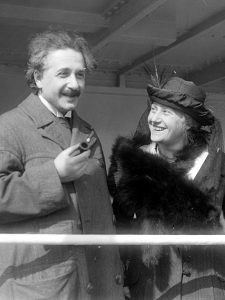 what could an average teacher teach him that he couldn’t learn on his own, and even begin to teach the teacher. I suppose that is the case with any genius, and it must have been a problem for many a teacher, not to mention to the child’s parents. Geniuses are a phenomena that most of us can only imagine, and maybe that is why it is felt that they should have a national day of their own. Often, the day is celebrated by a gathering of confirmed geniuses getting together to “show off” their skills. It is filled with competitions designed to exercise their minds in a group of their peers, which is definitely something they don’t get to do very often. I can’t think of a more fitting day for it to be celebrated than Albert Einstein’s birthday.
what could an average teacher teach him that he couldn’t learn on his own, and even begin to teach the teacher. I suppose that is the case with any genius, and it must have been a problem for many a teacher, not to mention to the child’s parents. Geniuses are a phenomena that most of us can only imagine, and maybe that is why it is felt that they should have a national day of their own. Often, the day is celebrated by a gathering of confirmed geniuses getting together to “show off” their skills. It is filled with competitions designed to exercise their minds in a group of their peers, which is definitely something they don’t get to do very often. I can’t think of a more fitting day for it to be celebrated than Albert Einstein’s birthday.
 A fire always draws crowds of spectators, and the crowds that gathered at New York City’s pier 88 on February 9, 1942 were no different. The billowing smoke drew their attention, and they were witness to the fire, and in the end, the loss of the SS Normandie…the largest ocean liner in the world at that time. Valiant fire fighting efforts successfully contained the fire after five and a half hours, but the effort was in vain. Five hours after the flames were out the SS Normandie rolled onto its side and settled on the bottom of the Hudson River.
A fire always draws crowds of spectators, and the crowds that gathered at New York City’s pier 88 on February 9, 1942 were no different. The billowing smoke drew their attention, and they were witness to the fire, and in the end, the loss of the SS Normandie…the largest ocean liner in the world at that time. Valiant fire fighting efforts successfully contained the fire after five and a half hours, but the effort was in vain. Five hours after the flames were out the SS Normandie rolled onto its side and settled on the bottom of the Hudson River.
The SS Normandie was intended to be the pride of the French people. The ship was designed to be the height of shipbuilding technology and modern culture. The first class passenger spaces were decorated in the trendiest Art Deco style and filled with all the latest luxuries. The radical new hull design, with a subsurface bulb beneath a clipper bow, and long, sweeping lines gave her previously untouched speeds, while requiring far less fuel. In order to improve the safety for the passengers, the ship even had one of the earliest radar sets ever used by a commercial vessel.
Still, with all of Normandie’s modern touches, there was to be no salvation for the great ship. The Normandie was put into service during the height of the Great Depression. A sign of her future, seemed to predict trouble when, on launching, the wave she kicked up smashed into hundreds of onlookers, though no one was injured in this accident. The ship performed spectacularly during trials, but would never prove to be a particularly successful ship, only making just enough to cover her operating expenses and never paying for the loans needed to finance her construction. The French declaration of war on Germany in September 1939 found the Normandie in New York, tied up alongside of pier 88. In spite of the loss of 28 American lives when a German u-boat torpedoed the Athenia on the first day of hostilities, the United States remained neutral. Nevertheless, authorities immediately put Coast Guard troops on board the Normandie and interned her in accordance with international maritime law. Though the French crew would remain aboard maintaining the vessel, she had to remain beside the pier, guarded by the Coast Guard, for two long years until the United States entered into the war. Five days after the attack on Pearl Harbor, the French crew were removed from Normandie. France was technically a German ally under the Vichy government, and as such the US government exercised the right to  seize the ship as belonging to an enemy nation. The ship was renamed the USS Lafayette, in honor of the French General who had helped make the United States independence possible during the revolution. The US Navy took possession of the vessel and began her conversion as a troop transport.
seize the ship as belonging to an enemy nation. The ship was renamed the USS Lafayette, in honor of the French General who had helped make the United States independence possible during the revolution. The US Navy took possession of the vessel and began her conversion as a troop transport.
The conversion was a rushed job, as the ship was intended to set sail under the US flag on the 14th of February, 1942. However, given the size of the ship, and the complexity of its design, it proved a to be a substantial hindrance to the men performing the conversion. By February 6th, it was clear that the conversion would not be completed on time, and the conversion crew requested that the sail date be pushed back two weeks. The request was denied, and the frazzled crew rushed into a frantic effort to complete the work on time. Tragically, this forced haste set up the conditions for a disaster. Work spaces were not properly cleaned or prepared for lack of time to do it, and unsafe conditions became the norm. At 2:30 PM on February 9th, a welder in the first class lounge was performing work next to life preservers that should have been moved ahead of time. The sparks ignited the life preservers. The ship’s modern firefighting system should have prevented the tragedy, but it had been disabled during the conversion and was unavailable to be brought back online. The New York Fire Department responded within 15 minutes, but were horrified to learn the French fittings on the Normandie/Lafayette were not compatible with their hoses. Less than an hour after the fire broke out, the ship was a raging inferno. To help fight the blaze firefighters employed fire boats on the port side of the ship, while firefighters used dockside hoses to tackle the flames on the starboard side. The fight to put out the fires took over five hours, but ultimately it was a success. The fire was declared out by 8:00 PM that evening.
Unfortunately, they realized that they now had a new problem. The fire boats attacking the port side blaze pumped water at a far greater volume than was used by the dockside hoses on the starboard side. The Normandie/Lafayette was listing heavily to Port, submerging a number of open portholes on that side. The Navy attempted to counterflood to right the list, pumping water into the starboard side so that the ship would settle evenly, but It was too late. At a quarter till three, the Lafayette rolled over on her side and settled into the mud at the bottom of the Hudson River. The fire injured 285, with injuries ranging from smoke inhalation to burns. One Brooklyn native, Frank Trentacosta, died in the tragedy. The Normandie remained on the bottom for a year and a half, before finally being righted and floated in August of 1943. It was determined to be too badly damaged to be salvageable, and was sold and broken up for scrap in 1946.
The loss of the Normandie alongside of New York’s pier 88 signaled the end of an era. While ocean liners would remain the principle means to cross the Atlantic until commercial jet liners became available. Nevertheless, 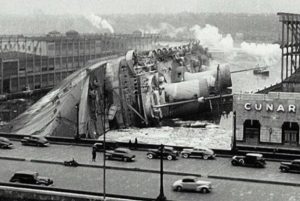
very few ocean liners would be constructed in the post war period. None of these ships would approach either the speed or size of the Normandie. The last dedicated ocean liner to be constructed, the Queen Elizabeth II would hit the water in 1969. Most liners would eventually be removed from service to be converted into cruise liners for tourist jaunts, though a few stubborn holdouts would remain. Today only one ship continues to run the route of the old ocean liners. Constructed as a cruise ship, the Queen Mary II was launched in 2003 as a means by which tourists can attempt to recapture the experiences of the luxurious passages the Normandie had been constructed to provide in days gone by.

 On January 30, 1933, President Hindenburg appointed Adolf Hitler chancellor of Germany. It wasn’t because of any election, but rather by a constitutionally questionable deal dreamed up by a small group of conservative German politicians who had given up on parliamentary rule. Little did they know that they were party to appointing one of the worst dictators in history. Their attempt to return Germany to conservative authoritarian rule, backfired miserably when, within two years, Hitler and the Nazis outmaneuvered Germany’s conservative politicians to consolidate a radical Nazi dictatorship that was completely subordinate to Hitler’s personal will. I wonder if President Hindenburg wished he had never met Hitler, much less appointed him to be chancellor.
On January 30, 1933, President Hindenburg appointed Adolf Hitler chancellor of Germany. It wasn’t because of any election, but rather by a constitutionally questionable deal dreamed up by a small group of conservative German politicians who had given up on parliamentary rule. Little did they know that they were party to appointing one of the worst dictators in history. Their attempt to return Germany to conservative authoritarian rule, backfired miserably when, within two years, Hitler and the Nazis outmaneuvered Germany’s conservative politicians to consolidate a radical Nazi dictatorship that was completely subordinate to Hitler’s personal will. I wonder if President Hindenburg wished he had never met Hitler, much less appointed him to be chancellor.
Within days of taking power, the Nazis called for Germany to boycott all Jewish businesses. This unexpected anti-Jewish propaganda was the first of many. Hitler hated the Jewish people. He had no reason for his hatred. The Jewish people had done nothing to warrant Hitler’s hatred and rage. One theory is that Hitler had decided that the Jewish people were an inferior race. That is not such a new thought. It had happened before, to the African slaves in history, who had often been referred to as mud people. The Jews, as with the slaves, were treated horribly.
Another reason Hitler hated the Jewish people, was because following Germany’s loss of World War I, Hitler blamed the Jews and the communists living in Germany. He felt that they were part of a huge conspiracy against the German military. He believed that had it not been for their interference, Britain and the allies would have lost the war. Another possible reason for Hitler’s hatred of the Jews was probably jealousy. After World War I, he saw that a lot of Germans were without jobs and struggling. Instead of looking at the war as the root cause of the economic problem, he blamed the Jews for the sorry state of affairs. Because Adolf Hitler was truly insane, I’m sure that his reason to hate the Jewish people made sense to him, but the reality is that his insane mind was the only place that it made sense.
I’m not sure how he managed to get so many people to agree with is ideas, but somehow he did, and when he decided that all Jewish shops were to be boycotted, and stationed his SA Storm Troopers near the shops to 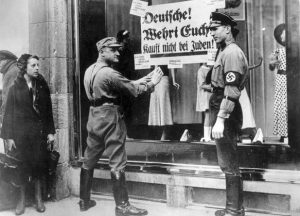
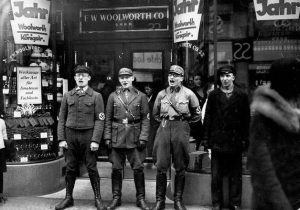
ensure that his plans were carried out, they did as they were told. It wasn’t long after the boycotting of the shops that Hitler took things to the next level, and began hauling the Jewish people to the death camps. As long as he was alive, there was no end to his hatred, and that is definitely not what President Hindenburg or the conservative German politicians had in mind, and I’m sure they wished they had never done it.
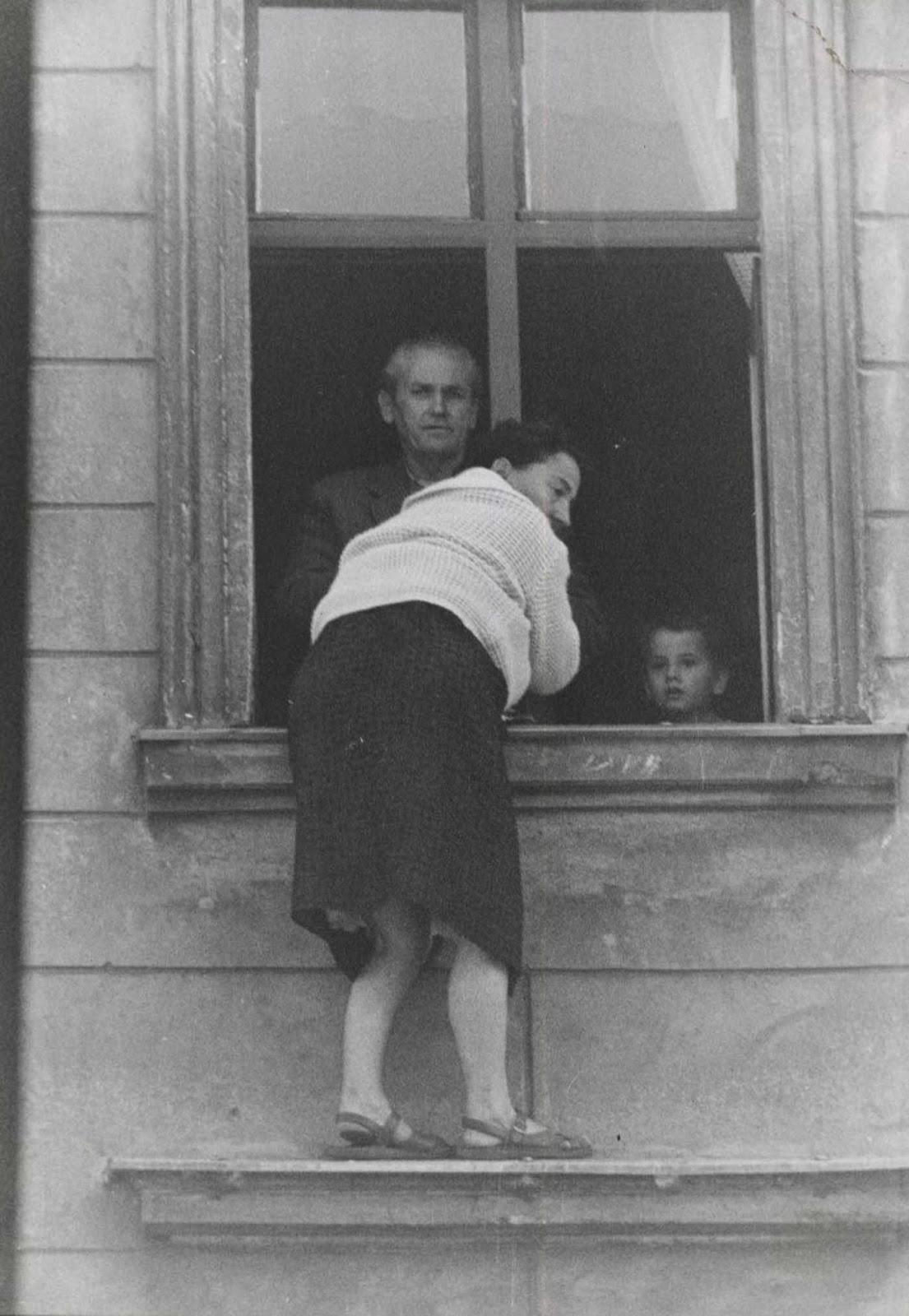 Imagine a world in which you could go to sleep living in freedom, and wake up behind prison walls…and you didn’t leave your home. That is exactly what happened to the people who lived in East Berlin. The Berlin Wall was erected overnight on August 13, 1961. The people of East Berlin were prisoners in their own city. Many of them had friends and family members who lived in West Berlin, but they were no longer allowed to go and see them, nor could the West Berliners come to East Berlin to see the inhabitants of that part of the city. The people in East Berlin were in a panic, and yet nothing could be done to free themselves from their plight. At least, not until they began to get very creative.
Imagine a world in which you could go to sleep living in freedom, and wake up behind prison walls…and you didn’t leave your home. That is exactly what happened to the people who lived in East Berlin. The Berlin Wall was erected overnight on August 13, 1961. The people of East Berlin were prisoners in their own city. Many of them had friends and family members who lived in West Berlin, but they were no longer allowed to go and see them, nor could the West Berliners come to East Berlin to see the inhabitants of that part of the city. The people in East Berlin were in a panic, and yet nothing could be done to free themselves from their plight. At least, not until they began to get very creative.
Many attempts were made in an effort to escape their captors, and many of those failed, but it would be the successful attempts at escape that would stay in our minds all these years. It was the successful attempts that were written about and celebrated in history, because those people won against a tyrannical government. One such escape was captured in pictures. Early in the construction, before most people even knew what was going on, Willy Finder figured it out and took steps to get his family out. His was a daring plan,but the people of West Berlin were willing to help pull it off. Willy’s wife was the first to go. I con only imagine how she must have felt. The plan required her to jump from the window ledge of their 4th story 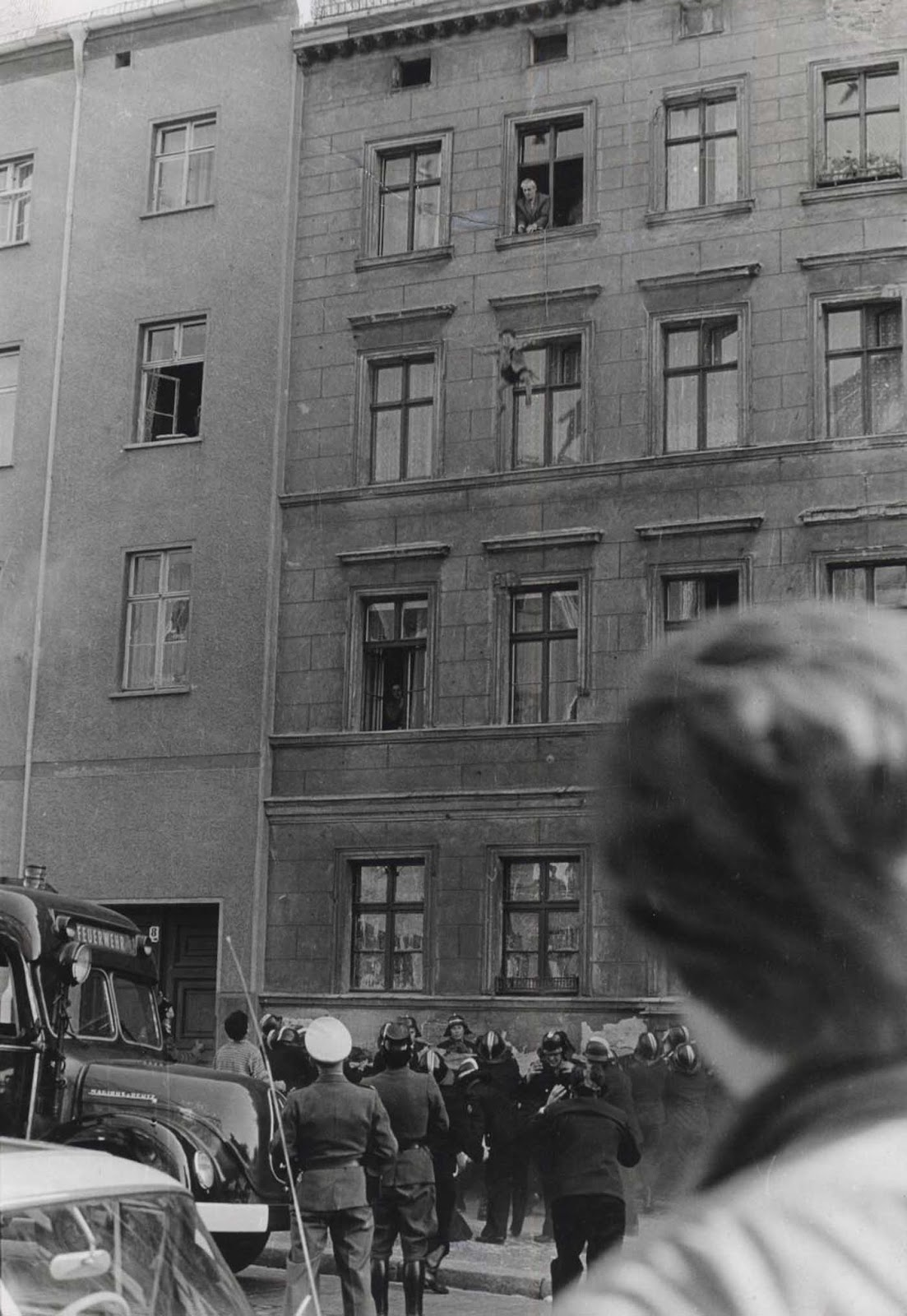 apartment, into a net held by residents and firemen in West Berlin. These apartments were along Bernauer Straße (street) in Berlin. The building actually saddled the border between East and West Berlin. After the wall was first constructed in 1961, many residents escaped through these apartment blocks, in this manner. So many, in fact, that the Soviets finally bricked up the windows and raided the apartments, evicting the people who lived there. After his mother jumped, four year old Michael Finder was tossed by his father to the waiting net below. There was no time to explain all this to his son…no time to reassure him. His daddy simply had to toss in out the window. Then Willy Finder made the jump himself. Theirs was a successful escape, one of many, and this infuriated the Soviet Union, because this was a part of the Soviet occupation zone formed after the reconstruction that followed World War II.
apartment, into a net held by residents and firemen in West Berlin. These apartments were along Bernauer Straße (street) in Berlin. The building actually saddled the border between East and West Berlin. After the wall was first constructed in 1961, many residents escaped through these apartment blocks, in this manner. So many, in fact, that the Soviets finally bricked up the windows and raided the apartments, evicting the people who lived there. After his mother jumped, four year old Michael Finder was tossed by his father to the waiting net below. There was no time to explain all this to his son…no time to reassure him. His daddy simply had to toss in out the window. Then Willy Finder made the jump himself. Theirs was a successful escape, one of many, and this infuriated the Soviet Union, because this was a part of the Soviet occupation zone formed after the reconstruction that followed World War II.
The Soviet occupation zone in Germany, and in Berlin, was suffering from numerous movements of educated individuals from their sectors toward the West throughout the 1950s. This movement, thought to be a brain drain, encouraged the Soviet Union to begin construction of a “Fascist Protection Wall” that was supposed to keep East Germans protected from “Fascism” that the Western Allies had “not eradicated in their sectors.” Of course, the reality was that the wall, later called the Berlin Wall, was designed to keep East Germans from emigrating to the West. The apartments 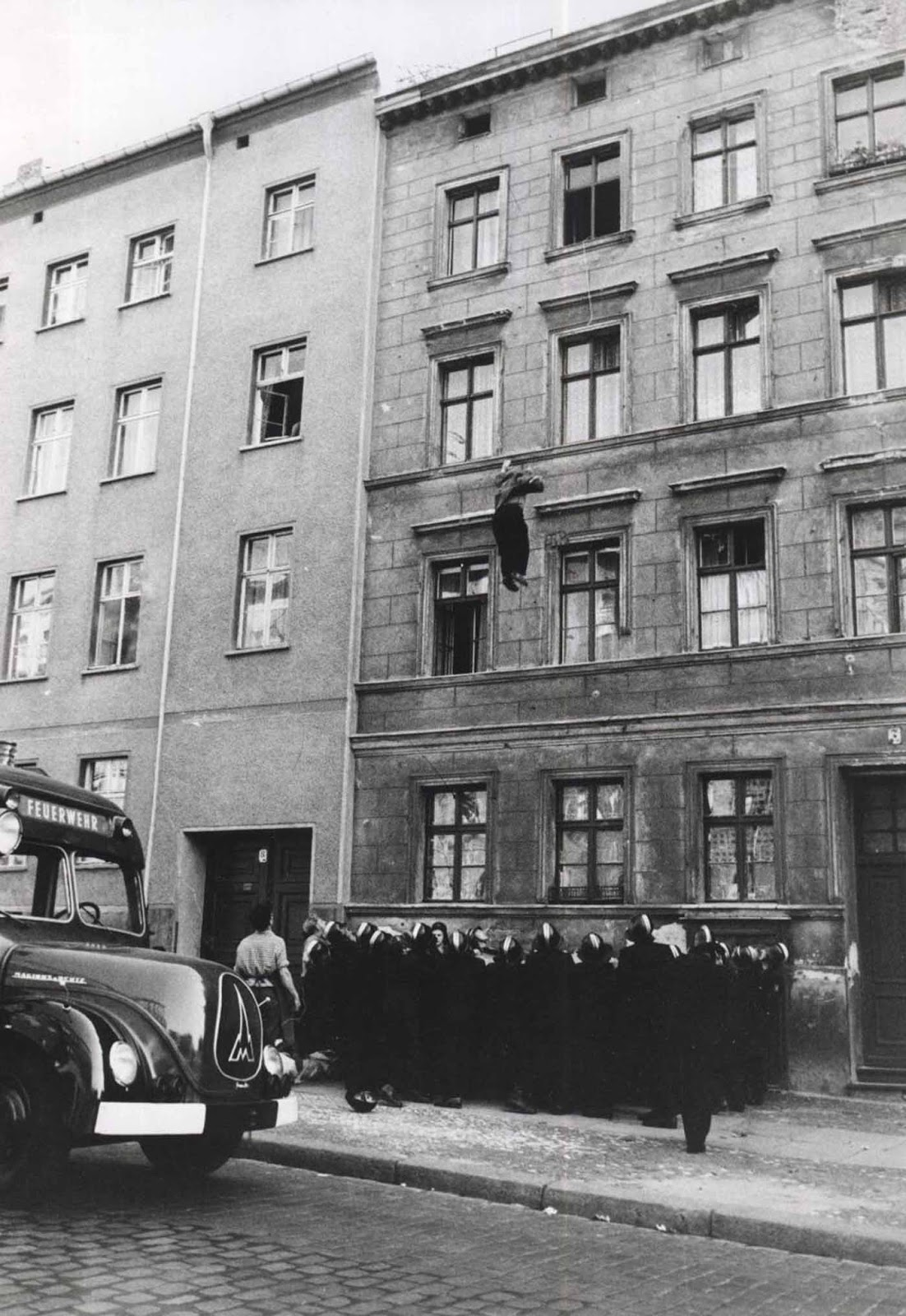 where the Finders lived were later torn down and the Berlin Wall that most of us picture in the news reels, and have chunks of in our museums all over the world, was erected. Nevertheless, between 1945 and 1988, around 4 million East Germans migrated to the West. The majority…as many as 3½ million people left between 1945 and the construction of the Berlin Wall in 1961. Of those, most simply walked across the border. After 1952, they exited through West Berlin. After the border was fortified and the Berlin Wall was constructed, the number of illegal border crossings fell drastically. The numbers fell further as border defenses were improved over the following decades. In 1961, 8,507 people fled across the border, most of them through West Berlin. The construction of the Berlin Wall that year reduced the number of escapees by 75% to around 2,300 per year for the rest of the decade. The Wall changed Berlin from being one of the easiest places to cross the border, from the East, to being one of the most difficult. The wall was finally torn down on June 13, 1990, and the German people were again free to move around the country.
where the Finders lived were later torn down and the Berlin Wall that most of us picture in the news reels, and have chunks of in our museums all over the world, was erected. Nevertheless, between 1945 and 1988, around 4 million East Germans migrated to the West. The majority…as many as 3½ million people left between 1945 and the construction of the Berlin Wall in 1961. Of those, most simply walked across the border. After 1952, they exited through West Berlin. After the border was fortified and the Berlin Wall was constructed, the number of illegal border crossings fell drastically. The numbers fell further as border defenses were improved over the following decades. In 1961, 8,507 people fled across the border, most of them through West Berlin. The construction of the Berlin Wall that year reduced the number of escapees by 75% to around 2,300 per year for the rest of the decade. The Wall changed Berlin from being one of the easiest places to cross the border, from the East, to being one of the most difficult. The wall was finally torn down on June 13, 1990, and the German people were again free to move around the country.
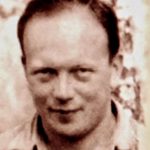 Heroes come in many forms, but few could be said to have been as sneaky as Eugene Lazowski, who was born Eugeniusz Slawomir Lazowski, in 1913 in Poland. His bravery was combined with genius, and in the end, he saved 8,000 Polish Jews at the height of the Holocaust. Lazowski saw the horrible way the Jews were treated, and he saw a way to help. Eugene Lazowski had just finished medical school when the Nazis invaded Poland in 1939. Typhus was spreading across the country. The disease was killing an average of 750 people a day. In an attempt to contain the disease, the Nazis increased their isolation and execution of Jews. Eugene joined the Polish Red Cross, but he was forbidden by the Nazis from treating Jewish patients. Nevertheless, under the cover of darkness, he sneaked into the Jewish ghetto and took care of the people there. Lazowski’s plan took an incredible amount of intellect, not to mention bravery. His life was on the line too. Lazowski created the illusion of an epidemic of a deadly disease, playing on the deep fears of the Nazis.
Heroes come in many forms, but few could be said to have been as sneaky as Eugene Lazowski, who was born Eugeniusz Slawomir Lazowski, in 1913 in Poland. His bravery was combined with genius, and in the end, he saved 8,000 Polish Jews at the height of the Holocaust. Lazowski saw the horrible way the Jews were treated, and he saw a way to help. Eugene Lazowski had just finished medical school when the Nazis invaded Poland in 1939. Typhus was spreading across the country. The disease was killing an average of 750 people a day. In an attempt to contain the disease, the Nazis increased their isolation and execution of Jews. Eugene joined the Polish Red Cross, but he was forbidden by the Nazis from treating Jewish patients. Nevertheless, under the cover of darkness, he sneaked into the Jewish ghetto and took care of the people there. Lazowski’s plan took an incredible amount of intellect, not to mention bravery. His life was on the line too. Lazowski created the illusion of an epidemic of a deadly disease, playing on the deep fears of the Nazis.
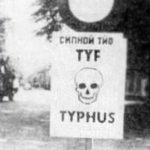 The plan came about in an unusual way. One day, a Polish soldier on leave begged Eugene and his colleague, Dr Stanislaw Matulewicz, to help him avoid returning to the warfront. I think there were many people who fought on the Nazi side of that era, who would give anything not to take part in what the Nazis were all about. Matulewicz had discovered that by injecting a healthy person with a vaccine of dead bacteria, that person would test positive for epidemic typhus without experiencing the symptoms. In an attempt to help the young solider fake a life-threatening illness, the doctors who had discovered that a dead strain of the Proteus OX19 bacteria in typhus would still lead to a positive test for the disease. Eugene realized that this could be used as a defense against the Nazis.
The plan came about in an unusual way. One day, a Polish soldier on leave begged Eugene and his colleague, Dr Stanislaw Matulewicz, to help him avoid returning to the warfront. I think there were many people who fought on the Nazi side of that era, who would give anything not to take part in what the Nazis were all about. Matulewicz had discovered that by injecting a healthy person with a vaccine of dead bacteria, that person would test positive for epidemic typhus without experiencing the symptoms. In an attempt to help the young solider fake a life-threatening illness, the doctors who had discovered that a dead strain of the Proteus OX19 bacteria in typhus would still lead to a positive test for the disease. Eugene realized that this could be used as a defense against the Nazis.
The two doctors hatched a secret plan to save about a dozen villages in the vicinity of Rozwadów and Zbydniów not only from forced labor exploitation, but also Nazi extermination. Lazowski began distributing the phony vaccine widely. Within two months, so many new (fake) cases were confirmed that Eugene successful 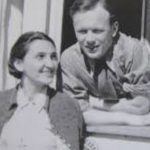 convinced his Nazi supervisors a typhus epidemic had broken out. The Nazis immediately quarantined areas with suspected typhus cases, including those with Jewish inhabitants. In 12 other villages, Eugene created safe havens for Jews through these quarantines. His work would eventually save 8,000 Jewish lives.
convinced his Nazi supervisors a typhus epidemic had broken out. The Nazis immediately quarantined areas with suspected typhus cases, including those with Jewish inhabitants. In 12 other villages, Eugene created safe havens for Jews through these quarantines. His work would eventually save 8,000 Jewish lives.
When the war ended, Eugene continued to practice medicine in Poland until he was forced to flee with his family to the United States. They settled in Chicago, where Eugene earned a medical degree from the University of Illinois. Decades later, he finally returned to Poland, where he received a hero’s welcome for saving those in desperate need of salvation through his unyielding love for humanity.
 When the colonists left England to form America, they were like the younger sibling, at least when it came to language and much of how they ran the country. Nevertheless, like that younger sibling, things began to change pretty quickly. Part of the change was due simply to distance. When you don’t hear a language all the time, you begin to vary in your own speech. I didn’t really realize there was such a difference between American English and British English, other than the accent of course. Still, I noticed that more and more forms were asking which of the two I spoke. I always thought that it was an odd question, because English is English…right? Well, the correct answer is…wrong!! And when I thought about it, I knew that to be true.
When the colonists left England to form America, they were like the younger sibling, at least when it came to language and much of how they ran the country. Nevertheless, like that younger sibling, things began to change pretty quickly. Part of the change was due simply to distance. When you don’t hear a language all the time, you begin to vary in your own speech. I didn’t really realize there was such a difference between American English and British English, other than the accent of course. Still, I noticed that more and more forms were asking which of the two I spoke. I always thought that it was an odd question, because English is English…right? Well, the correct answer is…wrong!! And when I thought about it, I knew that to be true.
The changes began almost immediately after the first Englishman set foot on American soil. It all started with “Americanisms.” These “Americanisms” have been created or changed from other English terms to produce a language that differs from our forefathers, signifying our uniqueness and independence. I’m sure our founders were rather pleased with themselves with this process, if they realized it at all. By the time of the first United States census, in 1790, there were four million Americans, 90% of whom were descendants of English colonists. When I think of the speed of that growth, it strikes me as phenomenal to say the least. Because of the large English background, there was no question that our official native language would be “English,” but it would not be the same as that spoken in Great Britain. “Americanism” means a word or expression that originated in the United States. The term includes outright coinages and foreign borrowings which first became “English” in the United States, as well as older terms used in new senses first given them in American usage.
In fact, by 1720, the colonists knew that we did not speak the same language as the people in England. The most obvious reason was, of course, the sheer distance from England. Nevertheless, that was not the only  reason. Over the years, many words were borrowed from the Native Americans, as well as other immigrants from France, Germany, Spain, and other countries. We had to communicate with the people around us too, and other words that became obsolete “across the pond,” continued to be utilized in the colonies. In other cases, words simply had to be created in order to explain the unfamiliar landscape, weather, animals, plants, and living conditions that these early pioneers encountered. These things might not have existed in England.
reason. Over the years, many words were borrowed from the Native Americans, as well as other immigrants from France, Germany, Spain, and other countries. We had to communicate with the people around us too, and other words that became obsolete “across the pond,” continued to be utilized in the colonies. In other cases, words simply had to be created in order to explain the unfamiliar landscape, weather, animals, plants, and living conditions that these early pioneers encountered. These things might not have existed in England.
By 1756, the English would make the first “official” reference to the “American dialect.” Samuel Johnson made note of it a year after he published his Dictionary of the English Language. Johnson’s use of the term “American dialect” was not meant to simply explain the differences, but rather, was intended as an insult. It was rather like calling our language the “low class” version of the English language. Remember if you will, that there were those who did not think the United States should ever be a sovereign nation. Years earlier…as early as 1735, the English were calling our language “barbarous,” and referred to our “Americanisms” as barbarisms. The English sneered at our language, something that continued for more than a century after the Revolutionary War, as they laughed and condemned as unnecessary, hundreds of American terms and phrases.
Our newly independent Americans, were proud of their “new” American language, wearing it, as a badge of independence. In 1789, Noah Webster wrote in his Dissertations on the English Language: “The reasons for American English being different than English English are simple: As an independent nation, our honor requires us to have a system of our own, in language as well as government.” Our leaders, including Thomas Jefferson and Benjamin Rush, agreed. It was not only good politics, it was sensible. The feelings of the “rest of the world” didn’t matter. The language changed even more during the western movement as Native American and  Spanish words became a part of our language.
Spanish words became a part of our language.
In 1923, the State of Illinois General Assembly, passed the act stating in part: “The official language of the State of Illinois shall be known hereafter as the “American” language and not as the “English” language.” A similar bill was also introduced in the U.S. House of Representatives the same year but died in committee. Now, after centuries of forming our “own” language, the English and American versions are once again beginning to blend as movies, songs, electronics, and global traveling bring the two “languages” closer together once again.
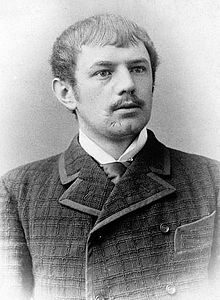 Hitler was undoubtedly one of the most horrible dictators of all time, but what prompted him to become the evil man he was. The story actually begins before Hitler was even born. In 1868, a baby named Dietrich Eckart was born in Neumarkt, Germany, on March 23, the son of a royal notary and law counselor. My guess is that he had a fairly normal childhood…at least until his mother died when he was just ten years old. That may not seem like an event that was unique to Eckart, but somehow it was different, or would become different. Eckart’s life was further complicated when his father died seventeen years later in 1895. At this point, Eckart inherited a considerable sum of money, and started to study medicine in Munich. That would be the last of his somewhat normal life. He spent his father’s money very quickly, and recklessly.
Hitler was undoubtedly one of the most horrible dictators of all time, but what prompted him to become the evil man he was. The story actually begins before Hitler was even born. In 1868, a baby named Dietrich Eckart was born in Neumarkt, Germany, on March 23, the son of a royal notary and law counselor. My guess is that he had a fairly normal childhood…at least until his mother died when he was just ten years old. That may not seem like an event that was unique to Eckart, but somehow it was different, or would become different. Eckart’s life was further complicated when his father died seventeen years later in 1895. At this point, Eckart inherited a considerable sum of money, and started to study medicine in Munich. That would be the last of his somewhat normal life. He spent his father’s money very quickly, and recklessly.
With his money gone, Eckart quit school, and began work as a poet, playwright, and journalist. He moved to Berlin in 1899, where he wrote a number of plays, often with autobiographical traits. Apparently, he was about the only one interested in his plays, because despite becoming the protegé of Graf Georg von Hülsen-Haeseler, the artistic director of the royal theaters, he never was successful as a playwright. Taking his madness one step further, he blamed his failure on society. This was the beginning of the insanity that became Dietrich Eckart. Later on, Eckart developed an ideology of a “genius higher human,” after reading earlier writings by Lanz von Liebenfels. Eckart saw himself like Arthur Schopenhauer and Angelus Silesius, and also became fascinated by Mayan beliefs, but never had much sympathy for the scientific method. That makes sense, because he seemed to want to make up his own truths. Eckart also loved and strongly identified with Henrik Ibsen’s Peer Gynt.
In 1913, when he moved back to Munich, he joined up with Rudolf von Sebottendorff’s right wing Thule Society, and became very politically active. He wrote the nationalist play “Heinrich der Hohenstaufe” (“Heinrich of the High Baptism”), in which he made the claim to world leadership for the German people, craziness that he would eventually pass along to Hitler. Soon he became the editor of the anti-semetic periodical Auf gut Deutsch. Eckart opposed the Treaty of Versailles, which he described as treasonous, and instead spread the so-called Dolchstoßlegende, which stated that the social democrats and Jews were to blame for Germany’s defeat in World War I. He was involved in the founding Deutsche Arbeiterpartei (German Workers’ Party) together with Gottfried Feder and Anton Drexler in 1919, which later on was renamed Nationalsozialistische deutsche Arbeiterpartei (National Socialist German Workers’ Party, NSDAP). He invented and published the NSDAP’s own periodical Völkischer Beobachter, and also wrote the songtext “Deutschland erwache” (Germany awake), which became the anthem of the Nazi party.
Adolf Hitler was born April 20, 1889, just a few years before Eckart’s dad’s passing. During a speech he gave before party members on August 14 1919, Eckart met Adolf Hitler. He exerted considerable influence on Hitler in the following years. Hitler looked at him as his “fatherly friend.” On November 9 1923, Eckart was involved in  the Nazi party’s failed Beer Hall Putsch,as was Hitler. They were arrested and sent to Landsberg prison along with other party officials, but he was released again soon due to illness. He died of a heart attack caused by a morphine addiction in Berchtesgaden on December 26, 1923. Hitler later dedicated the first volume of Mein Kampf to Eckart, and also named the Waldbühne in Berlin “Dietrich-Eckart-Bühne” when it was first opened for the 1936 Summer Olympics. In 1925, Eckarts unfinished essay, Der Bolschewismus von Moses bis Lenin. Zwiegespräch zwischen Hitler und mir (“Bolshevism from Moses to Lenin. Dialogues between Hitler and me”), was posthumously published, although it has been shown that it the dialogues were an invention. The essay was, in fact, written by Eckart alone. I don’t know what Hitler would have been like had e not met Eckart. My guess is that the evil ideas Hitler had were there before their meeting, but I do believe that Eckart had a great influence on Hitler,and probably helped formulate some of the evil that was to come.
the Nazi party’s failed Beer Hall Putsch,as was Hitler. They were arrested and sent to Landsberg prison along with other party officials, but he was released again soon due to illness. He died of a heart attack caused by a morphine addiction in Berchtesgaden on December 26, 1923. Hitler later dedicated the first volume of Mein Kampf to Eckart, and also named the Waldbühne in Berlin “Dietrich-Eckart-Bühne” when it was first opened for the 1936 Summer Olympics. In 1925, Eckarts unfinished essay, Der Bolschewismus von Moses bis Lenin. Zwiegespräch zwischen Hitler und mir (“Bolshevism from Moses to Lenin. Dialogues between Hitler and me”), was posthumously published, although it has been shown that it the dialogues were an invention. The essay was, in fact, written by Eckart alone. I don’t know what Hitler would have been like had e not met Eckart. My guess is that the evil ideas Hitler had were there before their meeting, but I do believe that Eckart had a great influence on Hitler,and probably helped formulate some of the evil that was to come.
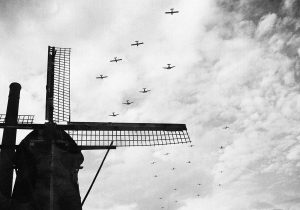 It has been 74 years since 17,740 Americans gave their lives to liberate the people of the Netherlands (often called Holland) from the Germans during World War II, and the people of Holland have never forgotten that sacrifice. For 74 years now, the people of the small village of Margraten, Netherlands have taken care of the graves of the lost at the Margraten American Cemetery. On Memorial Day, they come, every year, bringing Memorial Day bouquets for men and women they never knew, but whose 8,300 headstones the people of the Netherlands have adopted as their own. Of the 17,740 who were originally buried there, 9,440 were later moved to various paces in he United States by their families. “What would cause a nation recovering from losses and trauma of their own to adopt the sons and daughters of another nation?” asked Chotin, the only American descendant to speak on that Sunday 4 years ago. “And what would keep that commitment alive for all of these years, when the memory of that war has begun to fade? It is a unique occurrence in the history of civilization.”
It has been 74 years since 17,740 Americans gave their lives to liberate the people of the Netherlands (often called Holland) from the Germans during World War II, and the people of Holland have never forgotten that sacrifice. For 74 years now, the people of the small village of Margraten, Netherlands have taken care of the graves of the lost at the Margraten American Cemetery. On Memorial Day, they come, every year, bringing Memorial Day bouquets for men and women they never knew, but whose 8,300 headstones the people of the Netherlands have adopted as their own. Of the 17,740 who were originally buried there, 9,440 were later moved to various paces in he United States by their families. “What would cause a nation recovering from losses and trauma of their own to adopt the sons and daughters of another nation?” asked Chotin, the only American descendant to speak on that Sunday 4 years ago. “And what would keep that commitment alive for all of these years, when the memory of that war has begun to fade? It is a unique occurrence in the history of civilization.”
The people of Margraten immediately embraced the Americans, who had come to their aid when they needed it most. The town’s mayor invited the company’s commanders to sleep in his home, while the enlisted men slept in the schools. The protection against rain and buzz bombs was welcomed. Later, villagers hosted U.S. troops when the men were given rest-and-recuperation breaks from trying to breach the German frontier defenses, known as the Siegfried Line. “After four dark years of occupation, suddenly [the Dutch] people were free from the Nazis, and they could go back to their normal lives and enjoy all the freedoms they were used to. They knew they had to thank the American allies for that,” explained Frenk Lahaye, an associate at the cemetery.
By November 1944, two months after the village’s 1,500 residents had been freed from Nazi occupation by the U.S. 30th Infantry Division the town’s people were filled with gratitude, but the war wasn’t over. In late 1944 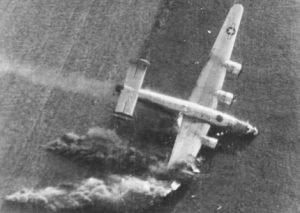 and early 1945, thousands of American soldiers would be killed in nearby battles trying to pierce the German defense lines. The area was filled with Booby-traps and heavy artillery fire. All that combined with a ferocious winter, dealt major setbacks to the Allies, who had already suffered losses trying to capture strategic Dutch bridges crossing into Germany during the ill-fated Operation Market Garden.
and early 1945, thousands of American soldiers would be killed in nearby battles trying to pierce the German defense lines. The area was filled with Booby-traps and heavy artillery fire. All that combined with a ferocious winter, dealt major setbacks to the Allies, who had already suffered losses trying to capture strategic Dutch bridges crossing into Germany during the ill-fated Operation Market Garden.
Now, the U.S. military needed a place to bury its fallen. The Americans ultimately picked a fruit orchard just outside Margraten. On the first day of digging, the sight of so many bodies made the men in the 611th Quartermaster Graves Registration Company ill. The bodies arrived in a procession of trucks and trailers. Death hung in the air over the whole village of Margraten. The sight of so much death caused a few of the people helping with the burials to become ill. They suddenly made a break for the latrines. The first burial at Margraten took place on November 10, 1944. Laid to rest in Plot A, Row 1, Grave 1: John David Singer Jr, a 25-year-old infantryman, whose remains would later be repatriated and buried in Denton, Maryland, about 72 miles east of Washington. Between late 1944 and spring 1945, up to 500 bodies arrived each day, so many that the mayor went door to door asking villagers for help with the digging. Over the next two years, about 17,740 American soldiers would be buried here, though the number of graves would shrink as thousands of families asked for their loved ones’ remains to be sent home, until 8,300 remained, and still, the graves are cared for by the town’s people, as if the dead were their own loved one. Not only that, but they have taken it upon themselves to research the deceased, and learn of their lives as a way of showing honor to these fallen heroes.
On May 29, 1945, the day before the cemetery’s first Memorial Day commemoration, 20 trucks from the 611th  collected flowers from 60 different Dutch villages. Nearly 200 Dutch men, women and children spent all night arranging flowers and wreaths by the dirt-covered graves, which bore makeshift wooden crosses and Stars of David. By 8am, the road leading into Margraten was jammed with Dutch people coming on foot, bicycle, carriages, horseback and by car. Silent film footage shot that day shows some of the men wearing top hats as they carried wreaths. A nun and two young girls laid flowers at a grave, then prayed. Solemn-faced children watched as cannons blasted salutes. The Dutch, Shomon wrote, “were perceptibly stirred, wept in bowed reverence.” All they do for these heroes is because they have vowed never to forget.
collected flowers from 60 different Dutch villages. Nearly 200 Dutch men, women and children spent all night arranging flowers and wreaths by the dirt-covered graves, which bore makeshift wooden crosses and Stars of David. By 8am, the road leading into Margraten was jammed with Dutch people coming on foot, bicycle, carriages, horseback and by car. Silent film footage shot that day shows some of the men wearing top hats as they carried wreaths. A nun and two young girls laid flowers at a grave, then prayed. Solemn-faced children watched as cannons blasted salutes. The Dutch, Shomon wrote, “were perceptibly stirred, wept in bowed reverence.” All they do for these heroes is because they have vowed never to forget.

